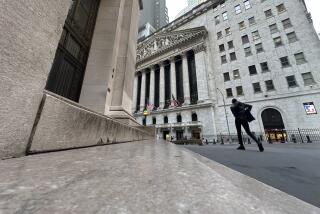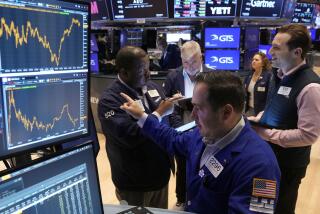Pandemonium in Europe Boosts Dollar : Markets: Investors rush to the greenback as a safe harbor. Gold prices rise steeply, but stocks end slightly down.
- Share via
The deepening monetary crisis in Europe sharply boosted the dollar on Wednesday as investors viewed the greenback as a safe haven.
The dollar’s rally, to 1.5140 German marks from 1.4910, boosted speculation that the U.S. currency may be mounting a sustained comeback from its recent all-time lows of just below 1.4 marks.
Meanwhile, gold prices also rose sharply. But stock prices lost more ground, bouncing around erratically as traders tried to sort out the outlook for foreign-exchange markets and interest rates worldwide. The Dow Jones industrial average, which fell 48.90 points on Tuesday, dropped another 8.11 points to finish the day at 3,319.21. And Treasury bond prices settled narrowly mixed as the market remained in a holding pattern.
Money traders aggressively sold British pounds and bought dollars even after the Bank of England raised interest rates from 10% to 15% and purchased large amounts of the British currency. Those steps should have made the pound more attractive.
The British later rolled back the interest-rate increase to 12% but suspended their membership in an exchange-rate agreement with other European countries that was aimed at keeping currency values stable toward one another.
The suspension means the British government isn’t obligated to use interest rate hikes to defend the pound. Interest rates in Britain are already among the highest in the world and are stifling economic growth there.
Britain’s actions were only part of a frenetic day marked by dramatic government interventions elsewhere in Europe. Sweden’s central bank raised a key lending rate to 500% in an attempt to defend the krona currency, while Italy’s central bank bought lire to support its value.
The aura of confusion only added to the sense that Europe’s effort to forge closer financial links is falling apart, only days before an important French vote Sunday on European economic unity.
That made many investors flee to dollar-denominated investments as a safe harbor, temporarily forgetting the unattractiveness of the dollar raised by the U.S. economy’s own economic malaise and the uncertain outcome of the presidential election.
“With Europe in such a big mess, the skirmish between George Bush and Bill Clinton doesn’t matter for the time being, so I go into the currency that I know,” said Zlatko Glamuzina, chief trader at the New York branch of Banco di Sicilia.
However, Federal Reserve Vice Chairman David W. Mullins Jr. downplayed the impact on the United States of the events of the last few days in Europe.
“I don’t believe there is any compelling reason to believe that the situation there is likely to have a negative effect on the U.S. economy,” said Mullins. Mullins described the turmoil as triggered by changes in “relative rates,” or the relationship of currencies within Europe to each other. “For that reason, it is likely to have less effect than if it was an absolute rate situation,” he said.
Mullins added that a recent cut in German interest rates probably will not effect the United States much and certainly will not hurt.
Mullins, who has long argued that the Fed should work to build sound economic fundamentals rather than intervene to influence the dollar’s value, suggested that the Fed would be following the same course.
But since no one seems sure about the outcome for European and U.S. rates, the financial markets are likely to remain chaotic at least for the short term, analysts said.
“The level of volatility and turmoil in the European foreign exchange, stock and bond markets is unprecedented,” said Hugh Johnson, chief investment officer at First Albany Corp. in New York. “I’m not sure that anyone can make sense out of this.”
The pound fell to $1.8083 in London from $1.8715 late Tuesday. Later in New York, the pound weakened further to $1.7855, down from $1.8635 late Tuesday.
In Tokyo, the dollar closed at 124.30 yen, down 0.58 yen from Monday. Tokyo markets were closed for a holiday Tuesday. Later in London, it rose to 124.90 yen. In New York, the dollar fetched 125.15 yen, up from 124.25 yen late Tuesday.
Other late dollar rates in New York vs. levels late Tuesday: 1.3230 Swiss francs, up from 1.3195; 1.2236 Canadian dollars, up from 1.2172; 5.1528 French francs, up from 5.0640, and 1,257 Italian lire, up from 1,205.50.
Stocks
In the broader market, declining issues outnumbered advances by about 5 to 4 on the New York Stock Exchange. Big Board volume rose to 231.6 million from 211.86 million in the previous session.
The stock market rallied sharply at the start of the week as German authorities cut interest rates, presumably breaking a logjam of conflicting monetary policies among major industrialized countries.
But by Tuesday analysts said investors came to a much less ebullient view of the situation, noting a variety of unresolved issues and questions.
Among the market highlights:
* Losers among the blue chips included International Business Machines, down 2 3/8 at 83 1/8; General Motors, down 5/8 at 33 1/4; Boeing, down 1 at 35 3/4; DuPont, down 1 1/8 at 46 3/4, and American Telephone & Telegraph, down 1/2 at 44 1/8.
* First Interstate Bancorp rose 2 1/8 to 38 3/8. The bank holding company raised its earnings forecast for 1992 and lowered its projected total of non-performing assets as of year-end.
* Syntex edged up 1/8 to 28 1/2 in active trading. The company said directors approved a plan to buy back as many as 7 million shares.
* Proteon, traded in the NASDAQ market, fell 3 3/4 to 11 1/4. The company said its third-quarter earnings would be below expectations and added that fourth-quarter results could disappoint as well.
* Topps Co., another NASDAQ issue, fell 3/4 to 16 3/4. The company posted quarterly earnings that came in a shade below what most analysts had been expecting.
In overseas trading, share prices finished higher on the London stock exchange despite the central bank’s moves. The broad-based Financial Times 100-share average closed up 8.3 points at 2,378.3. Earlier in the day, it had been down as much as 78.7 points.
In Frankfurt, shares see-sawed throughout the day, with the 30-share DAX average finishing the day down 2.99 points at 1,584.56.
Meanwhile, Tokyo stocks slumped below 18,000 as buyers wooed by government economic initiatives turned tail. The 225-share Nikkei average closed down 526.70 points, or 2.85%, at 17,944.70.
Credit
The price of the Treasury’s main 30-year bond, which fell Tuesday, lost an additional 1/4 point, or about $2.50 per $1,000 in face amount. Its yield, which rises when prices fall, was 7.33%, up from 7.31% late Tuesday.
“The world is in a currency crisis, and that is throwing every single market into frenzy,” said Peter McTeague, a fixed-income analyst with Thomson Financial Services in Boston. “Treasury bonds have weathered the storm pretty well.”
Should Germany lower rates, “it increases the odds of lower rates here, and that’s constructive” for bond prices, said David Hale, chief economist at Kemper Financial Services in Chicago. Lower German rates lessen the pressure on the Federal Reserve to keep domestic rates at current levels so that investors remain interested in U.S. fixed-income securities.
And with the U.S. recovery still stagnating, lower interest rates would help stimulate economic growth.
The federal funds rate, the interest on overnight loans between banks, fell to 3.125% from 3.188% late Tuesday.
Commodities
Gold prices rose strongly as investors alarmed by turmoil in world currency markets sought the traditional safe haven of precious metals.
Gold climbed $3.40 to $349.80 an ounce on New York’s Commodity Exchange.
Gold and other precious metals are perceived as safe investments in times of global turmoil because they tend to hold their value regardless of changes in foreign exchange rates.
On other commodity markets, grain and soybean futures were mixed; energy futures were mixed, and livestock and meat futures retreated.
Crude oil futures rose on the New York Mercantile Exchange as OPEC ministers meeting in Geneva searched for a formula that would allow crude prices to rise as much as $2 a barrel during the winter months.
Light, sweet crude oil for October delivery climbed 21 cents to $22.39 a barrel.
More to Read
Inside the business of entertainment
The Wide Shot brings you news, analysis and insights on everything from streaming wars to production — and what it all means for the future.
You may occasionally receive promotional content from the Los Angeles Times.










